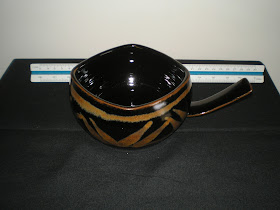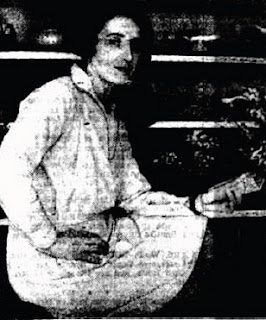Designer
|
Marcus Daniels
|
Maker
|
Marcus Daniels/Gulson Goulburn
|
Marks
|
Stamped “Gulson Goulburn”
inside oval cartouche with initials JD impressed to right beside stamp to
outside if base.
|
Material
|
Grey clay
|
Description
|
Gloss glazed earthenware
circular bowl with rim squared.
Unglazed flat foot ring. Dark
brown gloss glaze to interior, exterior and handle with striped double “V”
pattern to exterior inside brown banding at upper and lower exterior.
|
Condition
|
Very good. One handle broken
in transit
|
Number
|
No number
|
Production Date
|
1980s
|
Width at rim
|
11omm
|
Width at Base
|
100mm
|
Depth
|
65mm
|
Length (with handle)
|
206mm
|
Weight
|
490gm
|
Volume
|
650ml
|
Acquisition
|
E-Bay
|
Rameking Reference
Number
|
GUL 001-007
|
Gulson
Brick & Pottery Company was begun in Goulburn by potter Francis Gulson (1841-1927)
and operated from February 1884.
Francis and his wife Elizabeth first came to Goulburn from Albury in
1880 and started to Wollandale Brewery.
It shut down after four years.
Who would have thought you would lose money running a brewery in Australia? The problem was the water, and, as all
Tasmanians know, in beer, it’s the water that makes the difference. Drought had turned the water sour.
The company known originally as Gulson's
Brick & Pottery Company Pty Ltd manufactured other clay products including
tiles, stoneware pipes, fittings and terracotta wares. Originally the clay was prepared by being
milled in a horse-drawn pugmill. Bricks
were pressed by hand. This continued
until 1914 when a brick-making machine was imported from England. Newer kilns had been built by this
time.
Gulson is a name long associated with
brick-making. Back in Kelvedon, Essex
in England, Fredericks grandfather William Gulson managed a brickworks for the
local Lord of the Manor. (Some of the
brick-making machines at Gulsons came from Kelvedon.) Sons Francis and Luke came to Australia and began the Albury
Brickworks. Younger brother Thomas
followed later and became a partner with Francis.
Goulburn is Australia's
oldest inland city dating back to the earliest days of the colony. Many of the
buildings in the town have been built using bricks from the Gulson
Brickworks. Brother Luke had run a
brick-works in the border town of Albury.
Although Gulsons no longer operates as a brick-works, it became a tourist
and craft centre for a while. Like many brickworks
around Australia, Gulson not only made bricks, pipes and tiles, but also a
variety of other pottery including domestic wares.
Francis died in 1927 and the brickworks continued
under the management of four generations of the Gulson family until 1989 when
it closed and became the Gulson Craft Village.
Allan (Lyn) Gulson had managed the Illawarra Fireclay & Brick Co.
but came back to Goulburn in 1922 to run the Brickworks.
Craft-village pottery was made by potters working alone (or in
small groups), producing unique items in small quantities, typically with all making carried out by one
person. These ramekins date from that
time. The craft village contained a tea
room, potter and wood turner, housed in the vaulted ceilings of the salt glazed
interiors of the old kilns. These are some of the best
surviving examples of rectangular downdraught kilns.
The Wood-Turning shop at Gulsons 1999
Marcus Daniels was born in Darwin, Northern Territory and educated at St Patrick's College Goulburn. On completion of his secondary education, he enrolled at the East Sydney Technical School, where many famous Australian potters studied. A grant from the Arts Council allowed Marcus to complete further training at the Sturt Gallery under Ian Mackay, near Mittagong in New South Wales. Les Blakeborough had been in charge at the Sturt Gallery in the early 1950s. On his return to Goulburn in 1984, he set up shop as a full time potter.
























